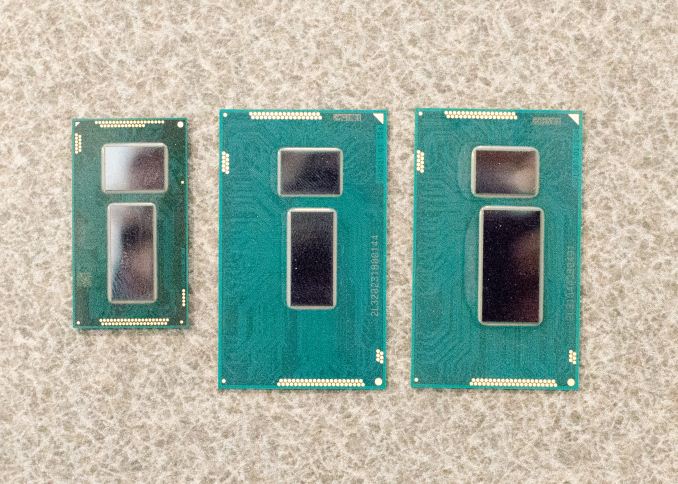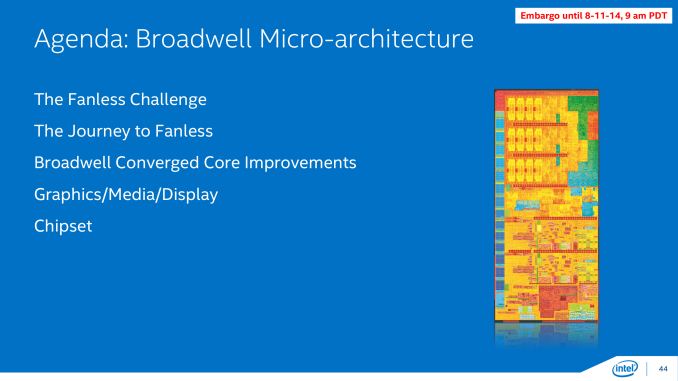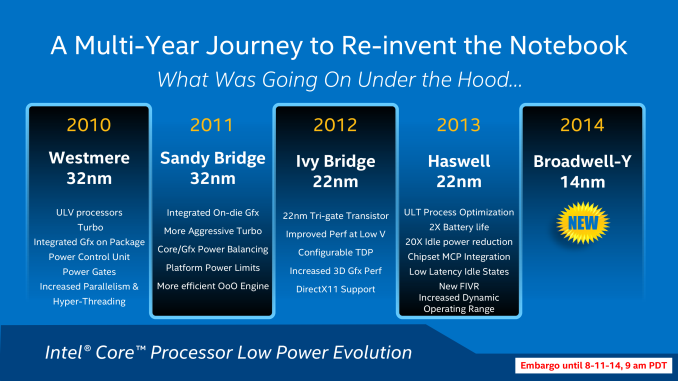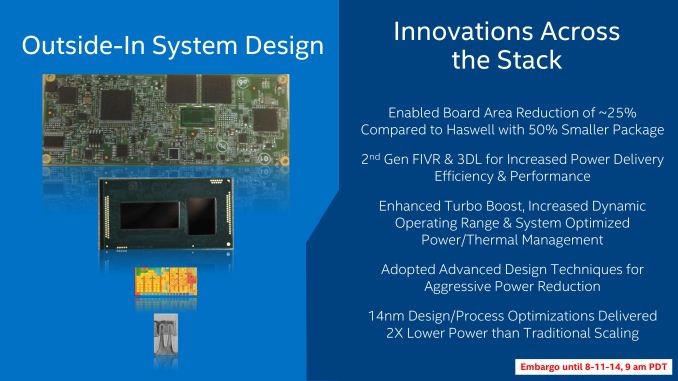Intel Broadwell Architecture Preview: A Glimpse into Core M
by Ryan Smith on August 11, 2014 12:01 PM EST
With Haswell Refresh fully behind us and 2014 now in to its second half, Intel is turning their attention to their next generation of products and processes. Intel’s tick-tock methodology coupled with the long development periods of new products means that the company has several projects in flight at any given time. So while we have seen the name Broadwell on Intel’s roadmaps for some time now, the reality of the situation is that we know relatively little about Intel’s next generation architecture and the 14nm process that it is the launch vehicle for.
Typically we would see Intel unveil the bulk of the technical details of their forthcoming products at their annual Intel Developer Forum, and with the next IDF scheduled for the week of September 9th we’ll see just that. However today Intel will be breaking from their established standards a bit by not waiting until IDF to deliver everything at once. In a presentation coinciding with today’s embargo, dubbed Advancing Moore’s Law in 2014, Intel will be offering a preview of sorts for Broadwell while detailing their 14nm process.
Today’s preview and Intel’s associated presentation are going to be based around the forthcoming Intel Core M microprocessor, using the Broadwell configuration otherwise known at Broadwell-Y. The reason for this is a culmination of several factors, and in all honesty it’s probably driven as much by investor relations as it is consumer/enthusiast relations, as Intel would like to convince consumer and investor alike that they are on the right path to take control of the mobile/tablet market through superior products, superior technology, and superior manufacturing. Hence today’s preview will be focused on the part and the market Intel feels is the most competitive and most at risk for the next cycle: the mobile market that Core M will be competing in.
To that end Intel’s preview is very much a preview; we will see bits and pieces of Broadwell’s CPU architecture, GPU architecture, and packaging, along with information about Intel’s 14nm process. However this isn’t a full architecture preview or a full process breakdown. Both of those will have to wait for Intel’s usual forum of IDF.
Diving into matters then, Core M will be launch vehicle for Broadwell and will be released for the holiday period this year. In fact Intel is already in volume production of the Broadwell-Y CPU and production units are shipping to Intel’s customers (the OEMs) to begin production and stockpiling of finished devices for the holiday launch.
Intel’s decision to initially focus Broadwell on the mobile market comes as the company takes the next step in their plan to extend into the Core processor series into these devices. Arguably, Intel has been slow to response to the rise of ARM devices, whose rapid rise has undercut traditional PC sales and quickly become the biggest threat to Intel’s processor dominance in some number of years. Intel is far from doomed right now, but even they see the potential farther down the line if they do not act.
Intel for their part has responded, but it has taken a step-by-step (multi-year) process that has seen the company progressively build smaller and less power hungry CPUs in order to fit the needs of the mobile market. Since Intel integrated their graphics on-die with Sandy Bridge in 2011, the company has continued to tweak the designs of their products, with Ivy Bridge and Haswell generation products introducing further optimizations and new manufacturing processes. Now on their latest iteration with Broadwell, the company believes they’re turning a corner and have the technology they need to be a leader in the high performance mobile market. It's important to note that despite Intel's best intentions here, Broadwell and Core M remain targeted at premium devices. You won't see these parts in cheap tablets. The duty of doing battle with ARM remains Atom's alone.
Many of these changes ultimately amount to boosting performance and reducing power consumption to a point where power and heat are where they need to be for mobile form factors, either through process efficiency improvements or through better power management and wider dynamic ranges – boosting where it matters and doing a better job of idling between tasks. However as Intel has discovered they not only need to be able to meet the TDP requirements of a tablet but they need to be able to meet the size requirements too. A particularly daunting task when the entire thickness of a device needs to be under 10mm, and the CPU thinner yet.
As a result, coupled with Core M’s performance improvements and power reductions is a strong emphasis on the size of the processor package itself and what Intel could do to reduce it. Intel calls this an outside-in system design, with various parts of Intel focusing on everything from the size of the logic board needed to hold the processor to the thickness of the processor die itself. In the following pages we’ll take a look at Intel’s efforts to get slim, but to kick things off we have a picture of Broadwell-Y from Computex 2014.

From left to right: Broadwell-Y (Core M), Broadwell ULT/ULX and Haswell ULT/ULX
Intel wants a greater foothold in the mobile market and they want it badly. And with Broadwell-Y they believe they finally have what they need to accomplish that goal.














158 Comments
View All Comments
IntelUser2000 - Wednesday, August 13, 2014 - link
Broadwell Y's CPU portion is on 14nm but the PCH is on 32nm.Not to mention that Intel's 22nm process isn't that small compared to Foundries 28nm. 28nm Foundry is ~30% larger than Intel 22nm not 100%.
20nm Foundry is really a half node jump from 28nm considering density improves but performance much less. 16nm is another half node since density barely changes but perf improves.
Really, it can only be judged as a product.
mkozakewich - Thursday, August 14, 2014 - link
The 'myth' was that x86 was a horrible power-sucking pig. It was shown that it was possible to at least get close to ARM processors.Meanwhile, Intel's chips are NOT as low-performance as Apple's. The chip in Surface Pro 3 is about 2x-3x faster, and these should be about the same. With this year's Apple chip, imagine it to be 2x faster or so. Meanwhile, they'll probably both take the same amount of power. SoCs these days are running multiples of Watts. Even Intel Atoms used to take over 10, but now a full Intel Core computer can run under 6 Watts. It would be really interesting to run all these numbers and give a complete report on the state of mobile vs. notebook processing. They seem matched on power usage, but ARM chips are far cheaper and run at far less performance.
peevee - Monday, August 11, 2014 - link
Finally, a long awaited fanless design. I don't care about thickness that much as about energy waste on the heat and the fan to dissipate the heat.But... I have 2008 MacBook Pro with 2.4GHz Pentium M. If they achieved fanless design by bringing frequency down to, say, 1.8GHz, I am not interested (given that IPCs are not that different for real world applications). For me to upgrade, I want it to reach 3GHz, even if for a second and in a single thread, when starting applications for example. Anything below that is not a noticeable upgrade, and below 2.2GHz or so will be downgrade in practice.
And biggest problem of Intel is not how thick they processors are, it is Microsoft - with Windows 8 (and 8.1) being so unbelievably awful (yes, I do own it for a while). Krzanich should call Nadella immediately and tell him to fire Larson-Green, or they both are going down.
MikhailT - Monday, August 11, 2014 - link
You do realize this is for tablets and low power laptops (Chromebook/netbook style) only, right?It's not coming to MBP for any time soon unless you're talking about something else entirely, like the MBA, which also is not going to get M either because it'll be too big of a regression on the performance.
I don't think we'll see any Macs with Core M.
ZeDestructor - Monday, August 11, 2014 - link
You forget about IPC. Last I checked, compared to a Core 2 CPU at equal clock speeds, a Sandy Bridge CPU is 50+% faster on average, and Haswell is a further 15+% faster on top of that, all the while using less power.Krysto - Tuesday, August 12, 2014 - link
Since this is the FIRST core to be "fanless", they're probably squeezing a lot of stuff to make that work, and it probably still overheats. I wouldn't be too excited about it until we see how it does in actual devices, both from a power consumption point of view, but also a performance one (because if performance didn't matter, then we'd all just use ARM chips, no?).It would be laughable if Denver, which already beats mainstream Haswell Celeron, would be in range of Broadwell Y in performance, but still more energy efficient and with much better GPU performance.
UNCjigga - Monday, August 11, 2014 - link
Time to spin up the 12" iPad Pro rumor mill again...but would Apple really need to build a device that runs 64bit iOS *and* OS X?ilt24 - Monday, August 11, 2014 - link
Apple doesn't seem all that interested in adding touch screen capabilities to OSX.isa - Monday, August 11, 2014 - link
OK, I'm confused, so any help appreciated. I want to replace my old desktop replacement laptop with a Broadwell equivalent. For example, the Broadwell version of an HP Envy 17t. What flavor of Broadwell am I waiting for? The Y flavor? U? H? Something else? thanks.mapesdhs - Monday, August 11, 2014 - link
I would ask the opposite: why do you need a replacement at all? What is it your current
device cannot do, or does poorly? Once the newer products are out, find out which one
solves those issues at the lowest cost. This focus on the jargon side of computing tech
is the absolute worst aspect of how consumer computing has evolved since the 1980s.
Ian.